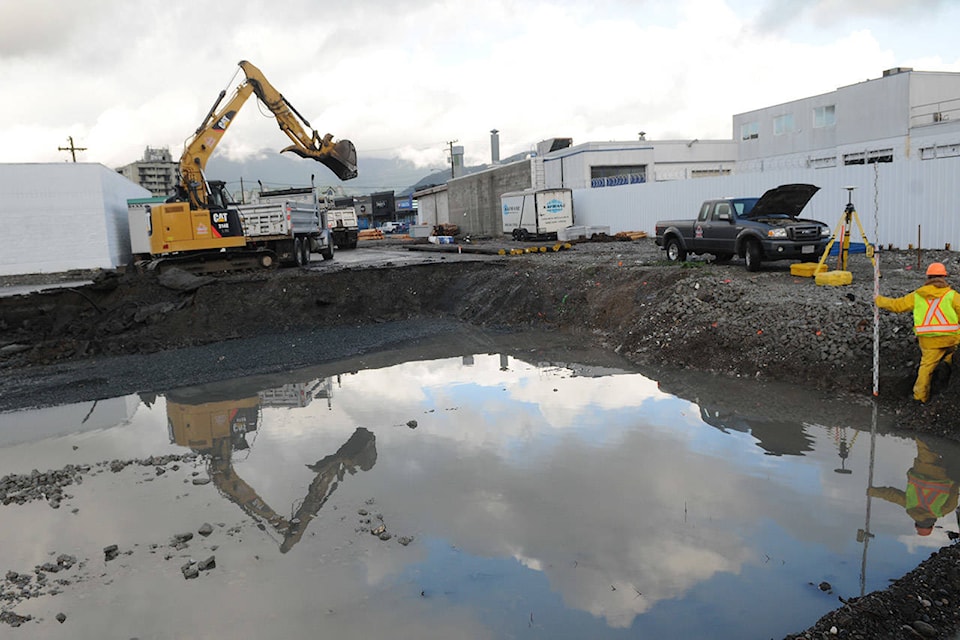As heavy equipment carved out space for the new modular housing facility on Yale Road this week, the Chilliwack Healthier Community (CHC) network gathered a few blocks away to hear updates on the key projects coming to address homelessness, mental health and addictions.
It was a packed house at the CHC breakfast meeting inside the Neighbourhood Learning Centre.
Most of the 11 projects on the agenda were of the bricks-and-mortar variety, but it also highlighted some planning processes that are also starting to yield results on the housing front.
The room buzzed with coffee chatter and excitement as a cross-section of more than 45 service providers and agency reps that make up the CHC network met that morning.
One by one, the 11 movers and shakers of the CHC gave five-minute presentations, with each providing a snapshot of one the projects coming down the pike.
The Homelessness Action Plan
The Homelessness Action Plan hammered out by City of Chilliwack and community partners is more than two years old.
READ MORE: Action Plan tackles the problem
So what has it accomplished? Plenty, the attendees heard by way of introduction. The projects, whether it’s a winter shelter that’s about to open, modular housing, or affordable housing under construction — are all manifestations of the action plan.
“It’s great that our community has come this far,” said Mike Sikora, who emceed the meeting as social development co-ordinator for City of Chilliwack, explaining how the homelessness action plan is starting to roll out in concrete ways.
| Mike Sikora, social development co-ordinator, City of Chilliwack. (Jennifer Feinberg/ The Progress)< |
Boldly embracing the Housing First approach for Chilliwack as the numbers of homeless skyrocketed, the action plan is aimed at creating more affordable housing supply, collaborating widely, and addressing the multi-pronged challenges of homelessness and substance use by taking a collaborative approach under the umbrella of the CHC.
The action plan has shifted the approach at city hall and put the emphasis on community collaboration, Sikora underlined.
“It helped us come up with projects and direction, but in addition it has changed policy at city hall,” he said.
An upshot of the plan now sees the city offering to waive development cost charges and fees worth millions of dollars, or in some cases facilitating an expedited approval process, when developers meet certain criteria, which can help as incentive when the need to act is urgent.
ICM team for Integrated Case Management
Connie Pauwels, clinical co-ordinator for Fraser Health, the ICM team lead in Chilliwack, said she anticipated working closely with the lead of the new modular supportive housing operators, RainCity Housing, to provide much-needed supports that come with the modular housing, for those who are homeless or at risk of homelessness, with substance/mental health issues.
| ICM team lead for Fraser Health, Connie Pauwels, right, with some ICM team members to her left. (Jennifer Feinberg/ The Progress)< |
Chilliwack is one of the few B.C. communities to get an Integrated Case Management (ICM) team to wrap the community’s most vulnerable citizens in support as they come in from the elements.
But what will an ICM team look like, once it’s in place, to help the once-homeless folks to stay housed?
The ICM team, when fully operational will include nurses, addiction specialists, Indigenous peer support and counsellors, housing support, a physician, and a psychiatrist all focused on that task.
Almost 100 Modular Supportive Housing units in 2019
Laura Caron, director of clinical services for RainCity Housing and Support Society, explained RainCity will operate both of the 46-unit modular supportive housing projects coming online next year, the former Traders Inn site on Yale Road, and the other on Trethewey Avenue.
“These are the dates we’ve been given so far: for Yale Road, hopefully we’ll be receiving keys and seeing tenanting in February of 2019, and Trethewey is slated to be tenanted in August of 2019,” Caron told the network.
That is just under 100 people who will be moving in, and have access to specialized support services, with a keen eye to the future of how to one day live independently without those services.
“In each of those buildings we’re looking at having 24-hour support available to folks to help them with all sorts of things: case management, life skills development, helping with room maintenance, if you will. We are really looking forward to having programming in both these buildings that will help them to transition on.”
What about affordable housing that is at or below market rental prices?
Here comes the Waterstone by MQHS
“We have The Waterstone, which we are due to open for tenants on March 1,” said Janice Silver, executive director of Mamele’awt Queesome Housing Society (MQHS).
MQHS officials are receiving 10 to 15 tenant applications per day on average, and they are going through them at the moment.
| The Waterstone on Yale Road by MQHS. (Jenna Hauck/ The Progress)< |
Final completion date for the Waterstone, located behind Canton Garden on Yale Road, is slated for February 18.
“We are hoping to have it fully housed by the end of April,” said Silver about the 80-unit affordable housing project. It will be pet friendly, but the suites will be non-smoking, with free daycare for Indigenous tenants in need.
The Waterstone will have 34 one-bedrooms ranging from $500 to $729 per month, 32 two-bedrooms from $700 to $945, and fewer three- and four-bedrooms.
“The new housing initiative does not come with subsidies, and that has presented a bit of a challenge,” said Silver, adding later that they will employ a slightly complicated formula based on income to determine rental rates.
RAN Family Centre in the DT skyline
Ruth and Naomi’s Mission is building a 36-unit Family Centre right behind its existing building, explained John Gray, RAN spokesperson. Rents will be fairly close to what the MQHS project will be renting apartments at, he said.
| RAN Family Centre (Jenna Hauck/ The Progress)< |
RAN is also the agency that will be operating the winter shelter on Yale Road East as of Dec. 3 with 24/7 staffing. But the Family Centre is the project that has been looming large in the downtown skyline.
The street closure at the south end of Fletcher Street makes it safer and leaves room for a playground to be built adjacent the on-site 20-space daycare.
“We’re calling it a ‘housing plus’ project, as opposed to ‘housing first,’” Gray said.
The first two floors of the Family Centre will have the wrap-around “wellness” services, including a teaching kitchen and the daycare. It will also feature a nine-bed women’s residential treatment centre, complementing the existing 26-bed men’s treatment centre.
“So we’re excited to be able to expand that service as well,” Gray said.
Sally Ann modular shelter a starting point
The homelessness action plan was the catalyst for the first modular shelter that went in earlier this year at the Chilliwack Salvation Army site on Yale Road.
| House of Hope at the Salvation Army site. (Jenna Hauck/ The Progress)< |
The modular shelter, named House of Hope, was the starting point for many seeking a way out of the cycle of homelessness.
“It’s part of the continuum of housing we’ve been talking about. That’s the starting point,” said Tim Bohr, director of community ministries for Salvation Army.
“What I want to express to the group is this is the first step for many to get off the streets,” Bohr said.
Butchart House custom built for five tenants
Sometimes one innovative housing project leads to another.
Annis Residence at the Chilliwack Health and Housing Contact Centre was having trouble finding vacant and affordable housing for its residents once they were ready to move on from two-year transitional housing program at the residence, said Barry Moore, residence manager of Pacific Community Resources Society (PCRS).
That’s what led to the BC Housing partnership forged by PCRS to bring about Butchart House, a five-bedroom house that was custom built and opened about a year and a half ago. Residents pay $500 per month and it has been working very well.
| Butchart House housing five people. (Jenna Hauck/ The Progress)< |
Housing Hub is busy housing people
The Housing Hub, a system-based way to house people who are homeless with supports like home visits, has been in operation since last August, said Housing Hub co-ordinator Graham McMahon.
“We currently have seven units of independent housing, with nine tenants who range in age from 20 to 68,” said McMahon. In terms of congregate housing, they have four units housing 11 people.
Twelve of those housed were chronically homeless, many for at least a year or more, and one woman was recently homeless, and many were imminently at risk of homelessness with multiple barriers.
“A big part of what we do is connecting people to wrap-around services,” McMahon said.
The Paramount Project for youth/seniors
The Paramount Project began as an inter-generational housing concept, with the idea of housing for youth and seniors above commercial space, but the RFP didn’t allow that combination, said Diane Janzen, executive director of Chilliwack Community Services (CCS).
| The site of the future Paramount Project, if approved. (Jenna Hauck/ The Progress)< |
Now the new proposal for the mixed use Paramount Project at the former Paramount Theatre site will feature 11 units of housing for youth aging out of care as well as for seniors. So CCS is submitting a new application for funding from BC Housing for the Paramount, with assurances from City of Chilliwack that it will donate the land and rezone it, so there will be more on that project to come in the near future.
“We’ll see if we get it, but we also feel that we can contribute to downtown revitalization,” Janzen added. “I’m sure you’ve seen all the changes that are already starting.”
CCS is so committed to the future of downtown, in fact, it is bringing all its operations there, Janzen said.
Ann Davis Transition Society opened women’s centre
Patti MacAhonic, executive director of Ann Davis Transition Society (ADTS), noted Chilliwack has the highest number of homeless women in B.C. at 40 per cent. Vancouver is the next highest at 22 per cent of its homeless population being women.
| ADTS women's centre (Jenna Hauck/ The Progress)< |
Opening their low-barrier, wheelchair accessible specialized women’s centre has helped, but the need is still great.
But they are still forced to turn away 70 to 80 women and 35 to 40 children per month, who have nowhere to go and are seeking shelter.
“We try to meet people where they are at,” said MacAhonic. “Women are really vulnerable and it’s so important to have distinct women’s services.”
READ MORE: What is Chilliwack doing about housing and homelessness
@CHWKjourno
jfeinberg@theprogress.com
Like us on Facebook and follow us on Twitter.


